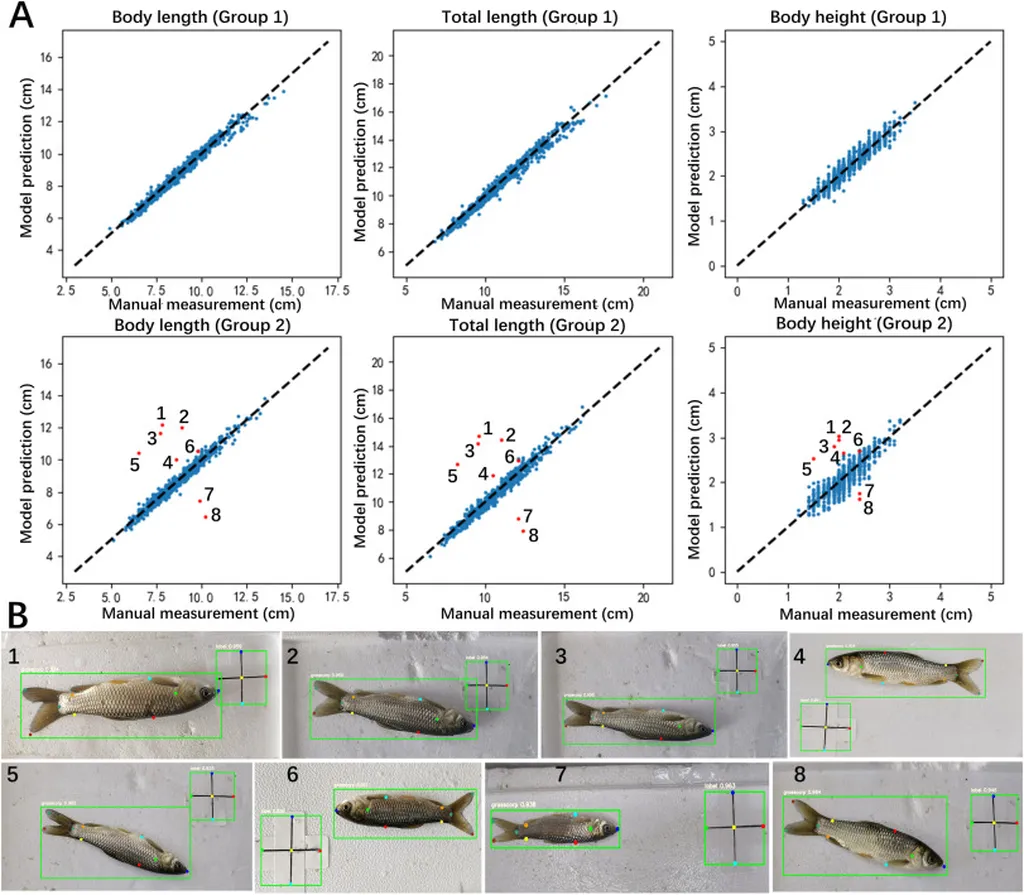In the dynamic world of aquaculture, precision is key, and a recent study published in *Smart Agricultural Technology* is set to revolutionize how we measure and monitor juvenile fish. The research, led by Xueqian Sun from the National Innovation Center for Digital Fishery at China Agricultural University, introduces a high-precision method for measuring phenotypic characteristics of juvenile spotted knifejaw (Oplegnathus punctatus), a species of significant commercial value in aquaculture.
The rapid swimming and frequent posture changes of juvenile fish have long posed challenges for accurate measurement using machine vision. Traditional methods often fall short, leading to inaccuracies that can impact the overall efficiency and profitability of fish farming. Sun and his team have developed a novel approach that combines keypoint detection, multi-segment measurement, and a weight estimation model to address these issues.
At the heart of this innovation is the YOLOv11-CCPose algorithm, enhanced with a ContextGuideFPN module to improve feature extraction. “By incorporating the ContextGuideFPN module, we significantly boosted the model’s ability to extract features from fast-swimming juveniles in various postures,” explains Sun. The team also improved the feature extraction module (C3K2) by integrating SMAFormer and Convolutional Gated Linear Units (CGLU), resulting in marked improvements in precision, recall, and mean average precision (mAP) compared to baseline models.
The study reports that YOLOv11-CCPose achieved a 3.2% improvement in precision, 2.7% in recall, 1.8% in [email protected], and 1.6% in [email protected]:0.95. These enhancements translate to a more robust system capable of handling the complexities of juvenile fish behavior.
Beyond keypoint detection, the researchers proposed a multi-segment measurement method to reduce errors in length and height measurements, even when fish are in bending postures. Additionally, they developed a WBP weight estimation model that uses dual features of length and height to estimate weight accurately.
The culmination of these advancements is a high-precision juveniles biomass estimation system. When tested under real aquaculture conditions, the system demonstrated impressive accuracy, with maximum measurement errors of 3.22% for length, 4.56% for height, and 6.00% for weight. The average errors were even lower, at 1.36% for length, 3.04% for height, and 4.21% for weight.
The implications for the aquaculture industry are profound. Accurate measurement of phenotypic characteristics is crucial for monitoring growth, optimizing feeding strategies, and ensuring the health and welfare of fish. “This system not only enhances the precision of measurements but also provides a feasible solution for real-world aquaculture applications,” says Sun.
The research, published in *Smart Agricultural Technology* and led by Xueqian Sun from the National Innovation Center for Digital Fishery at China Agricultural University, represents a significant step forward in the field of smart aquaculture. As the industry continues to embrace technological advancements, this high-precision measurement method is poised to become a standard tool for fish farmers, ultimately contributing to more sustainable and profitable aquaculture practices.
The study’s findings open up new avenues for research and development in the field of smart aquaculture. Future advancements could include the integration of this measurement system with other smart farming technologies, such as automated feeding systems and environmental monitoring tools. This holistic approach could further enhance the efficiency and sustainability of aquaculture operations, benefiting both the industry and the environment.
As the global demand for seafood continues to rise, innovations like this are essential for meeting the challenges of the future. By leveraging the power of machine vision and advanced algorithms, the aquaculture industry can achieve new levels of precision and efficiency, ensuring a sustainable supply of high-quality seafood for consumers worldwide.

